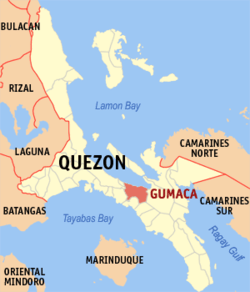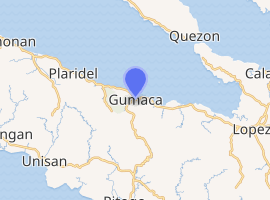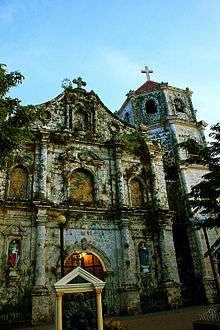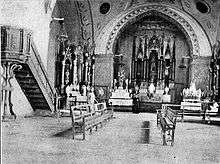Gumaca
Gumaca, officially the Municipality of Gumaca, (Tagalog: Bayan ng Gumaca), is a 1st class municipality in the province of Quezon, Philippines. According to the 2015 census, it has a population of 73,877 people.[3]
Gumaca | |
|---|---|
| Municipality of Gumaca | |
Muralla Boulevard at the mouth of Pipisik River | |
 Seal | |
 Map of Quezon with Gumaca highlighted | |

| |
.svg.png) Gumaca Location within the Philippines | |
| Coordinates: 13°55′16″N 122°06′01″E | |
| Country | |
| Region | Calabarzon (Region IV-A) |
| Province | Quezon |
| District | 4th District |
| Founded | November 13, 1582 |
| Barangays | 59 (see Barangays) |
| Government | |
| • Type | Sangguniang Bayan |
| • Mayor | Webster D. Letargo |
| • Vice Mayor | Erwin P. Caralian |
| • Congressman | Angelita D. Tan |
| • Electorate | 39,785 voters (2019) |
| Area | |
| • Total | 189.65 km2 (73.22 sq mi) |
| Elevation | 5.7 m (18.7 ft) |
| Population (2015 census)[3] | |
| • Total | 73,877 |
| • Density | 390/km2 (1,000/sq mi) |
| • Households | 17,334 |
| Economy | |
| • Income class | 1st municipal income class |
| • Poverty incidence | 13.1% (2015)[4] |
| • Revenue (₱) | 171,982,736.56 (2016) |
| Time zone | UTC+8 (PST) |
| ZIP code | 4307 |
| PSGC | |
| IDD : area code | +63 (0)42 |
| Climate type | tropical rainforest climate |
| Native languages | Tagalog |
| Website | gumaca |
Located at the mouth of what is now known as Pipisik River and nestling at the foot of the Sierra Madre range. The town is widely known as a heritage town due to the many ancestral houses and old structures that abound in the area, including a fortress from the Spanish era. The local government is currently conserving these heritage structures for future generations.
Barangays
Gumaca is politically subdivided into 59 barangays:
- Adia Bitaog
- Anonangin
- Bagong Buhay (Poblacion)
- Bamban
- Bantad
- Batong Dalig
- Biga
- Binambang
- Buensuceso
- Bungahan
- Butaguin
- Calumangin
- Camohaguin
- Casasahan Ibaba
- Casasahan Ilaya
- Cawayan
- Gayagayaan
- Gitnang Barrio
- Hardinan
- Inaclagan
- Inagbuhan Ilaya
- Hagakhakin
- Labnig
- Laguna
- Lagyo
- Mabini(Poblacion)
- Mabunga
- Malabtog
- Manlayaan
- Marcelo H. Del Pilar
- Mataas Na Bundok
- Maunlad (Poblacion)
- Pagsabangan
- Panikihan
- Peñafrancia (Poblacion)
- Pipisik (Poblacion)
- Progreso
- Rizal (Poblacion)
- Rosario
- San Agustin
- San Diego (Poblacion)
- San Diego (Bukid)
- San Isidro Kanluran
- San Isidro Silangan
- San Juan De Jesus
- San Vicente
- Sastre
- Tabing Dagat (Poblacion)
- Tumayan
- Villa Arcaya
- Villa Bota
- Villa Fuerte
- Villa Mendoza
- Villa Nava
- Villa Padua
- Villa Perez
- Villa Principe
- Villa Tañada
- Villa Victoria
Demographics
| Population census of Gumaca | ||
|---|---|---|
| Year | Pop. | ±% p.a. |
| 1903 | 5,324 | — |
| 1918 | 7,540 | +2.35% |
| 1939 | 12,904 | +2.59% |
| 1948 | 19,131 | +4.47% |
| 1960 | 27,284 | +3.00% |
| 1970 | 36,366 | +2.91% |
| 1975 | 39,337 | +1.59% |
| 1980 | 42,143 | +1.39% |
| 1990 | 48,195 | +1.35% |
| 1995 | 53,568 | +2.00% |
| 2000 | 60,191 | +2.53% |
| 2007 | 63,778 | +0.80% |
| 2010 | 69,618 | +3.24% |
| 2015 | 73,877 | +1.14% |
| Source: Philippine Statistics Authority[3][5][6][7] | ||
Climate
| Climate data for Gumaca, Quezon | |||||||||||||
|---|---|---|---|---|---|---|---|---|---|---|---|---|---|
| Month | Jan | Feb | Mar | Apr | May | Jun | Jul | Aug | Sep | Oct | Nov | Dec | Year |
| Average high °C (°F) | 26 (79) |
27 (81) |
29 (84) |
31 (88) |
31 (88) |
30 (86) |
29 (84) |
29 (84) |
29 (84) |
29 (84) |
28 (82) |
26 (79) |
29 (84) |
| Average low °C (°F) | 22 (72) |
22 (72) |
22 (72) |
23 (73) |
24 (75) |
24 (75) |
24 (75) |
24 (75) |
24 (75) |
24 (75) |
23 (73) |
23 (73) |
23 (74) |
| Average precipitation mm (inches) | 83 (3.3) |
55 (2.2) |
44 (1.7) |
37 (1.5) |
90 (3.5) |
123 (4.8) |
145 (5.7) |
125 (4.9) |
135 (5.3) |
166 (6.5) |
163 (6.4) |
152 (6.0) |
1,318 (51.8) |
| Average rainy days | 15.1 | 10.8 | 11.9 | 11.4 | 19.9 | 23.7 | 26.3 | 23.9 | 23.9 | 22.1 | 20.2 | 18.6 | 227.8 |
| Source: Meteoblue [8] | |||||||||||||
History
Formerly known as Bumaka (meaning "the one who fought"), the present town of Gumaca was a settlement founded at the southern bank of Palanas River in the 14th century by a group of settlers from Borneo and the Malay Peninsula. It is in fact only 11 years younger than the “Noble and Ever Loyal City of Manila”.[9]
The earliest known ruler was Lakan Bugtali. His sovereignty extended over the regions bordering Gusuan, now called Lamon Bay, from Gamao point to the North, to the island across the bay or now known as Alabat Islands, to the south-west passing the north-eastern part of the present town of Calauag, the source of Talolong, which traverses the town of Lopez, and Pandanan Rivers and on the north-west as far as the upper Kalilayan River. Thus when the first Spaniards arrived in this settlement in 1574 led by Fr. Diego de Oropesa, they found a group of barangays with their own culture and government. Gumaca, writes Juan Álvarez Guerra in Viajes por Filipinas: De Manila á Tayabas (2nd printing 1887), is first mentioned in the Franciscan register of 1582. This is the same year given by Huerta (1862). Fray Diego belonged to the batch of pioneering Franciscans under Juan de Plasencia who were assigned to explore the area presently the provinces of Rizal, Laguna and Quezon to determine future mission sites for the Franciscans.[10] They introduced Christianity to the people with San Diego de Alcala being proclaimed as the pueblo's patron saint. In 1582, the first “visita” was erected and 1686 marked the establishment of a full-pledged town with independent (civil) government, the earlier ones having been headed by the ever-present Spanish friars (The municipality boasts of a still complete line-up of chief executives from 1574 to the present.).[9]
From 1574 to 1670 the town of Gumaca was ruled by Spanish friars. Then from 1671 to 1893 the town was ruled by Spanish and Filipino Gobernadorcillos. From 1893 to 1900 the town executives came to be known as Capitan Municipal and from 1901 the head of the town was elected by the people and came to be known as Presidente Municipal. Later in 1936 this title was changed to Municipal Mayor.
The brief history of Gumaca had no mention of any law, decree or Republic Act which created the municipality and there was no mother municipality where Gumaca came from. As for its daughter towns, Lopez is the most notable among them, being one of the largest and the most progressive in that part of the province.[11]
Places of interest
San Diego de Alcala Fortress (Kutang San Diego)
Recognized by the National Historical Commission as a national treasure since 1981, this fortress was constructed by the Spaniards under the leadership of Franciscan priest Fray Francisco Coste. It was erected to help guard the town against pirates attacking from Lamon Bay, as well as from Dutch intruders during the 1700s. One can see some of the cannons still intact at the fort. According to some accounts, there used to be an existing tunnel between said fortress and the San Diego de Alcala Church, now a cathedral. Access was through a well located at the fort's platform, which is now covered. There are four fortresses constructed by the Spaniards, but only this one survived. It is a well-loved and famous landmark; it is included in the town's seal. Locals call the fortress kastilyo. There have been proposals to reconstruct the three other fortresses that were destroyed. The revival of the three forestresses would complete the original design of the four fortification ensemble of Gumaca, one of the most important fortification ensemble in the region during the Spanish era.
Lamon Bay
Known before as Gusuan Bay, Lamon Bay is named after Lam Ong, a pirate that was killed by Gumaca's earliest ruler, Lakan Bugtali. It is a body of water connecting the northern part of Quezon to the Pacific Ocean. It bounds the coastal towns of Atimonan, Gumaca, Plaridel, Lopez, and Calauag, and the islands of Alabat. It is a rich fishing ground and the home of various living corals. Most parts of the bay consist of gray sand, some parts are filled with rocks, and other living corals. It is gradually sloping to the extent that, during low tide, the water level is low enough to allow one to walk as far as five hundred meters from the shore. The beaches in the towns of Gumaca and Plaridel are sandy and ideal for swimming, especially, during the months of April and May (caution though during the latter part of May when jellyfishes start arriving). In some parts of the bay, about ten feet from the beach front, are living corals. The town of Lopez has the best colonies of corals which are located just about 15 minutes by boat from the shore. Lamon Bay is located at the northern part of Quezon.
San Diego de Alcala Cathedral

Its first establishment was in 1582 by the Franciscans, who are the first missionaries who brought Christianity to Gumaca, on its present site. It was transferred to Silangan in the island of Alabat, Quezon in 1638. It was burned by the Dutch forces in 1665, which subsequently resulted to them transferring back to its original site in Gumaca. The church was reconstructed in 1690 and completed in 1747. The edifice and the adjoining convent were beautified in 1846. When a strong earthquake hit Gumaca in 1937, the uppermost portion of the church belfry toppled down, leaving only three of the five-level belfry intact. During the term of Msgr. Jose Oliveros, the belfry and choirloft were reconstructed and was completed in 1999. Known as one of the biggest and oldest Catholic churches in the province of Quezon, it is located in Barangay San Diego Poblacion near the Municipal Government office. The church is made out of coral stone blocks and bricks.
Though the design of the church is mainly Baroque, archival photos show that the interiors were mainly done in Gothic Revival architecture. Its retablos and arco toral design clearly reflects this style, possible due to its popularity in the early 19th century. The church was renovated, and the retablos, together with the pulpit, were lost.

A statue of the Sacred Heart of Jesus can be found at the church park (locally known as patio). It directly faces the front door of the church. Some say that the eyes of the icon can be seen closed at some time, though it is open most of the time. The arch of the icon reflects the old retablo design of the church.
The cathedral is under the patronage of Saint Didacus of Alcala (San Diego in Spanish). He was born to a poor couple in San Nicolas del Puerto and was given to a hermit as a young child. He joined the Order of Friars Minor (more popular known as the Franciscans) which is a group advocating the simple, contemplative and self-sacrificing lifestyle of Saint Francis de Assisi. While Saint Didacus was assigned in the infirmary of the convent of Ara Coeli, many of the patients were miraculously cured upon his divine intercession. His final assignment was in Santa Maria de Jesus in Alcala where he lived a life of penance, solitude and contemplation. He died on November 12, 1463 due to abscess in Alcala (thus the name San Diego de Alcala). Instead of foul odor, his body emitted a fragrant smell and rigor mortis did not set in. He was canonized in 1588. His feast was made November 13 instead of November 12 in order to give way to Saint Martin. However, in 1969, his feast was correctly made November 12 after the feast of Saint Martin was moved to April 13.
Plaza Rizal
Dedicated to the national hero José Rizal, the park and monument were built in 1935 during the incumbency of Eriberto Caparros. By 1982, it was modernized, renovated, and lighted. It is located at Barangay Rizal in the town's poblacion. It features Rizal standing on a pedestal. Three women are seated at the base representing the three major island regions of the country; Luzon, Visayas, and Mindanao. The women are wearing native costumes from the regions they represent.
Muralla
Gumaca, being a coastal town, was originally a walled city. Old maps dating to the Spanish era shows that the coastline from the mouth of Pipisik River running a few hundred meters is a muralla or wall, made up of stone (most probably coral stones and/or bricks) and hardwood. There are no extant remnants of it, except for the San Diego de Alcala Fortress that is used to be a part of the wall. However, the boulevard is still called by the locals as muralla. A large part of the sea was reclaimed, and is now fashioned like the Baywalk of Manila Bay. Landscaped, lighted, and beautified by the local government, it is now a favorite place of Gumaqueños to hang out, play, bask in the cool ocean breeze, or watch the sun set. There are some stores and a bar located along the strip; drinking along the boulevard is however prohibited.
Culture
Araña't Baluarte Festival
The festival is celebrated every 15 May, in honor of San Isidro Labrador, the patron saint of farmers. This is also a thanksgiving feast for the bountiful harvest given to the farmers every year. Being an agricultural town, this is one of the most extravagant and well-attended festival of the town. The name means chandeliers (araña) and bastion or fort (baluarte). This festival is different from Pahiyas in Lucban – instead of houses being decorated with local produce, baluartes are decorated with various agricultural products like bananas, vegetables, buco, pineapple, and root crops; some are beautifully arranged in arañas. These crop decor are pulled out by the people after the patron saint has passed during the afternoon procession. The three most beautifully decorated baluartes are given prizes. At night, programs are held which includes a pageant aptly called "Mutya ng Araña't Baluarte", folk dances performed by students, teachers, and local townsfolk who would like to participate in the event.
Cultural tour
Quezon is a tapestry of old Spanish-style houses with Castilian architecture and character. Visit the old houses of Lucban, Tayabas, Sariaya, Gumaca, and Mauban while savoring the best of the yield from lanzones plantations. Or come during the San Isidro Festival in honor of the patron of farmers, San Isidro Labrador. Take home petered rice paste strung in garlands for a souvenir and celebrate with the people this feat of thanksgiving for a bountiful harvest.
Folk dances
Four (4) of our Folk Dances have originated in the Municipality of Gumaca: La Jota Gumaqueña, Polkabal, Mazurka Valse and Del Pilar.
La Jota Gumaqueña is a lively festival dance in Camohaguin, Gumaca, Quezon, which features stomping and elegant moves while using castanets and “Panderetas”. It is derived from the words Jota (two-four time) and valse (means waltz, a step or a dance in three-four time). Once very popular among the prosperous families of Gumaca. A well-known local musician at the time, Señor Herminigildo Omana, introduced this dance. It became popular with the young people and was handed down between generations. The male wears barong Tagalog and black trousers and female wears a Maria Clara dress.
Polkabal is a dance influenced by two distinct European styles: polka and valse.
Mazurka Valse features unique figures where the girl steps on the feet of the boy. They then proceed to do mincing step turns, walking steps, and lift the feet sideways right and left.
Local government
- Mayor: Webster Letargo
Municipal mayors
From the discovery in 1574 and official foundation of Gumaca in 1582, Franciscan Friars have been the Town Heads:
- Sr. Padre Diego de Oropesa (1574–1587)
- Sr. Padre Esteban Ortiz (1588–1598)
- Sr. Padre Geronimo Monte (1599–1622)
- Sr. Padre Gabriel Santo Tomas (1623–1637)
- Sr. Padre Marcelo de la Guardia (1638–1661)
- Sr. Padre Celestino de San Miguel (1662–1670)
From 1671, Gobernadorcillos are the Heads of Town dof Gumaca (Spanish period): (Mostly composed of Dynasties of Hispanic-Filipino Families)
- Don Diego Jose (1671–1672)
- Don Francisco Santa Maria (1673–1676)
- Don Pedro De Castro (1677–1679)
- Don Simon Prada (1680–1681)
- Don Mariano De Dios (1682)
- Don Jose San Agustin (1683)
- Don Santiago Abra (1684)
- Don Felix Gimenos (1684–1685)
- Don Juan Adriano (1686)
- Don Antonio Lopez (1686)
- Don Juan San Buenaventura (1687–1688)
- Don Jose Ajan de Vera (1689)
- Don Buenaventura dela Cruz (1690)
- Don Diego Martinez Polintan (1690)
- Don Manuel Cuello (1691)
- Don Don Gregorio Dandan (1692)
- Don Nicolas Sarmiento (1693)
- Don Francisco de Victoria (1694)
- Don Francisco Martinez (1695–1696)
- Don Juan Cabig (1697)
- Don Gaspar Catapang (1698)
- Don Francisco Escobar (1698–1699)
- Don Marcos Frias (1700)
- Don Pedro Talavera (1701)
- Don Francisco Martinez (1702)
- Don Diego Martinez Polonio (1703)
- Don Diego Salvador (1704)
- Don Francisco Cortez (1705)
- Don Antonio Santa Maria (1706)
- Don Pedro Talavera (1707)
- Don Francisco de Victoria (1708)
- Don Diego Martinez Polonio (1709)
- Don Pedro Talavera (1710)
- Don Buenaventura Delos Santos (1711)
- Don Francisco Clemente (1712)
- Don Juan Bautista (1712)
- Don Francisco Salvador Martinez (1713)
- Don Alejo Alonzo de Victoria (1714)
- Don Antonio Catapang (1715)
- Don Pedro Gimenes (1716)
- Don Francisco Clemente (1717)
- Don Geronimo Gimenes (1718)
- Don Pedro Almonte (1719)
- Don Pedro Patilo (1720)
- Don Santiago Martinez (1721)
- Don Bartolome Dandan Casadia (1722)
- Don Pedro Talavera (1723)
- Don Antonio Peras Margas (1724)
- Don Jose Pagayanon (1724–1725)
- Don Francisco de Victoria (1725–1727)
- Don Francisco Salvador (1728)
- Don Gregorio Gimenes (1729)
- Don Francisco Cordero (1730)
- Don Juan de Reyes (1731)
- Don Eugenio delos Santos (1732–1733)
- Don Francisco delos Reyes (1734)
- Don Francisco De Leon (1735)
- Don Andres Martinez (1736)
- Don Diego delos Santos (1737)
- Don Miguel delos Reyes (1738)
Presidentes Municipal (American period)
- Don Donato T. Arcaya (1901–1903) (First elected Presidente Municipal de Gumaca) Gobernadrocillo Interim (1900)
- Don Carlos Capisonda (1904–1905)
- Don Rafael Castro (1906–1907)
- Don Conrado Oliveros (1908–1909)
- Don Tomas Tañada, Sr. (1909–1912)
- Don Aurelio P. Nava (1912–1916) Son of Gobernadorcillo Don Antonino Nava
- Don Deogracias Tañada (1916–1919)
- Don Panfilo M. Tañada (1919–1923)
- Don Valeriano Arcaya (1923–1925) Son of Presidente Don Donato Arcaya
- Don Marciano Linay Principe (1925–1928)
- Don Don Eriberto Caparros (1928–1931)
- Don Francisco Omaña (1931–1934)
- Don Vicente M. Mendoza (1934–1939)
Japanese Occupation (1942–1946)
- Sr. Juan R. Tañada (1940–1946)
- Don Vicente D. Victoria (1946–1951) Son of Gobernadorcillo Don Pedro Victoria
After the Liberation, the Head of Town has been changed to Municipal Mayor:
- Sr. Mariano M. Tañada, Sr. (1952–1959) Son of Gobernadorcillo Don Vicente Tañada
- Dr. Cesar A. Angulo (1960–1963)
- Don Tomas C. Tañada, Jr. (1964–1967) Son of Presidente Don Tomas Tañada, Sr.
Martial Law Era: (1972–1981):
- Engr. Teodosio V. Principe (1968–1979) Son of Presidente Don Marciano Principe
- Col. Robert T. Yap-Diangco (1980–1986)
After EDSA People Power I: (1986):
- Cirilo M. Tañada (1986–1995) Son of Mayor Mariano M. Tañada, Sr.
- Col. Rodolfo B. Caralian (7/1/1995-8/16/1995) Died during his term of office
- Juanito B. Bañal (1995–2007)
- Engr. Joy Job Arcaya Cabangon (2007–2010)
- Engr. Erwin P. Caralian (2010–2019) Son of Mayor Col. Rodolfo Caralian
- Webster Letargo (2019 present)
References
- "Municipality". Quezon City, Philippines: Department of the Interior and Local Government. Retrieved 31 May 2013.
- "Province: Quezon". PSGC Interactive. Quezon City, Philippines: Philippine Statistics Authority. Retrieved 12 November 2016.
- Census of Population (2015). "Region IV-A (Calabarzon)". Total Population by Province, City, Municipality and Barangay. PSA. Retrieved 20 June 2016.
- "PSA releases the 2015 Municipal and City Level Poverty Estimates". Quezon City, Philippines. Retrieved 1 January 2020.
- Census of Population and Housing (2010). "Region IV-A (Calabarzon)". Total Population by Province, City, Municipality and Barangay. NSO. Retrieved 29 June 2016.
- Censuses of Population (1903–2007). "Region IV-A (Calabarzon)". Table 1. Population Enumerated in Various Censuses by Province/Highly Urbanized City: 1903 to 2007. NSO.
- "Province of Quezon". Municipality Population Data. Local Water Utilities Administration Research Division. Retrieved 17 December 2016.
- "Gumaca: Average Temperatures and Rainfall". Meteoblue. Retrieved 27 January 2020.
- "Gumaca – Wikimapia". Wikimapia.org. Retrieved 23 February 2017.
- "Fuerza de San Diego de Alcala • Gumaca, Quezon « Muog". Archive.today. 11 December 2012. Archived from the original on 11 December 2012. Retrieved 23 February 2017.
- "Gumaca, Quezon (History, Gov. Officials, Barangays, Population)". WowQuezon.com. Retrieved 23 February 2017.
External links
| Wikimedia Commons has media related to Gumaca, Quezon. |